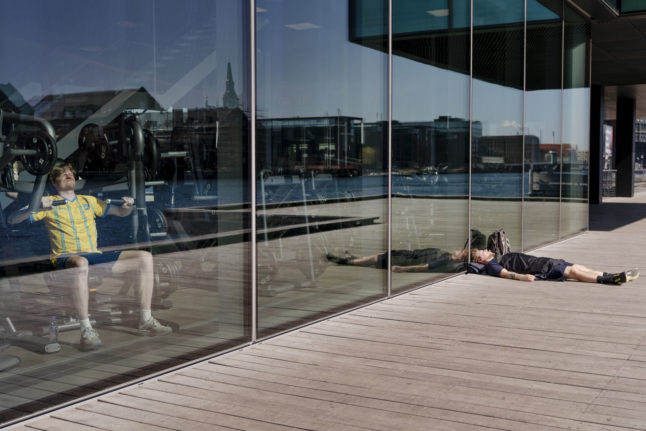Recycle your old jeans and dishcloths
From July 1st, textiles are added to food, plastic and paper as types of waste which must be sorted separately for recycling.
While old dishcloths or holed socks could previously be thrown out with regular waste, they must be sorted separately from now on, the Ministry of Environment said in a press statement.
“Too many clothes and textiles end up getting burned as general waste. We can do something about this when we sort a ruined top or carpet so it can get a new life,” Environment Minister Magnus Heunicke said in the statement.
Implementation of the new sorting rules will be determined by local authorities. This may have already taken place in some municipalities.
READ ALSO: Denmark adds textiles to list of waste to be sorted for recycling
Laughing gas broadly banned
People who use laughing gas in Denmark could receive a fine from police under new rules that come into force on July 1st.
The law bans the use of nitrous oxide, commonly known as laughing gas, in public places and also forbids its sale. Police can fine people who are found to be carrying nitrous oxide at places like music festivals, night clubs or places of education.
Fines of 3,000-5,000 kroner can be given for possession of laughing gas in public under the new law while selling the substance can elicit a fine of as much as 50,000 kroner.
READ ALSO: Denmark bans sales and public use of laughing gas
Copenhagen Jazz Festival
The streets of Copenhagen will hum with the groovy sound of summer jazz as the latest edition of the Copenhagen Jazz Festival begins on June 30th and continues for ten days until July 9th.
The annual festival is unique in that it does not have a specific location, but is played out in parks, on squares and in bars (and, of course, jazz clubs) across the capital. The size of the venues ranges equally from intimate and spontaneous to major concert halls.
Over 1,200 concerts are scheduled to take place and you can check out the programme on the event’s website.
School (and work) is out for summer
Denmark’s primary and lower secondary schools are already on their summer holidays, with the school year having ended on Friday, June 23rd for a full seven weeks.
Universities tend to break up a week later, with Copenhagen University’s spring semester ending on June 30th, and Aarhus University and the University of Southern Denmark both scheduling their last exams for June 30th.
Many people who work for Danish employers also take a considerable chunk of their annual leave in July, with annual vacation rules providing for ample time off during the month.
READ ALSO: What are the rules for taking annual leave in Denmark?
DSB’s summer travel pass can be used in most of July
The popular summer ticket scheme rejsepas from rail operator DSB is back for the fourth year in a row. The ticket gives the holder free access to all public transport in Denmark for eight consecutive days between June 24th and August 20th.
The ticket cannot be used in the very busiest summer period between July 22nd and July 30th, but the rest of the month is fair game.
The pass can be used on all DSB trains, as well as on Arriva buses and trains, one the Copenhagen Metro and S-train, on the Letbane in Aarhus and Odense, and on local rail services.
It costs 399 kroner for adults, who can bring two children under 12 with them for free. The pass costs 199 kroner for children aged 12-15 or otherwise not travelling under an adult ticket.
Sales of the pass are limited to 75,000 but DSB’s website is still showing availability at the time of writing.
READ ALSO: How to get (almost) free travel on Danish trains in summer 2023
Update to Positive List
The Positive List is a list of professions for which immigration authorities can issue work permits because Denmark is experiencing a shortage of qualified professionals in those fields.
People who are offered a job included in the Positive List can apply for a Danish residence and work permit based on the Positive List Scheme. An educational background in the relevant field is required.
The Positive List Scheme is one of a number of business schemes used to grant work permits for non-EU and EEA nationals who are unable to move to Denmark under the EU’s right to free movement.
The list is updated twice a year, on January 1st and July 1st.
The updated lists can be viewed on the website of the Danish Agency for International Recruitment and Integration (SIRI).
Changes to Denmark’s immigration rules were meanwhile introduced by parliament earlier this year. The changes were designed to make it easier to for companies to hire internationally, and added more job titles to the Positive List for People with Higher Education.
READ ALSO: How have work permit rules been changed in Denmark?
Tax deadline for businesses
If you are a business owner in Denmark you must register your results for 2022 at the beginning of July.
Information submitted up to and including July 1st will be considered submitted on time, the tax authority SKAT states on its website.
Companies whose accounting years run to December 31st can submit 2022’s results until August 23rd, the tax authority SKAT states on its website, after the original deadline of June 30th was extended.
Self-employed people are still bound by the July 1st deadline.
READ ALSO: So you missed Denmark’s July 1st tax deadline. Now what? (2021)



 Please whitelist us to continue reading.
Please whitelist us to continue reading.
Member comments